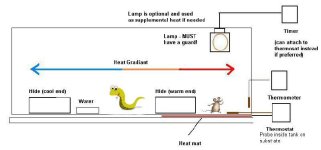hookfacedone
New member
I've been reading for 3 days and still, I'm confused.
I have a bunch of questions any answers would greatly be appreceiated.
Pease define primary and supplamental heat.
1. Is the idea to have the substrate/bottom of tank or the air within the tank at 80 degrees f?
2. If its the air then wouldnt heating pads be useless?
3. What wattage should be used in a tank that measures 30"l 13"w 18"h?
I would be using a thermostat.
4. Considering the stand which i'll have my tank on is wood and the heating pad is under the tank attached to the glass, should i put a few vent holes in the wood under the heating pad? I dont want any fires.
5. If the heating pad keeps the tank at the optimal temp do I need supplimental heater/light as well? such as a basking lamp to replicate the sun.
6. If I had to add a basking light would i position it over the heating pad?
I read this could cause fires, but if I put it away from the heating pad the tank wouldn't have the temp variant.
7. Is there a device thats a thermostat that has a day and night cycle? once again to replicate day and night.
8. I assume that the thermostat has a probe that it uses to indicate temp, if i'm using a heating pad could I just touch the probe to the bottom of the tank?
My plan as of now;
A low watt fluorescent strip
(for aesthetic resons) have it on a timer to be on for 10 or so hours a day.
A heating pad (i dont know what wattage yet) running on some type of thermostat.
And most likely use paper towels for substrate (although i would like to give it the option of burrowing)
a few hides, water dish and mayb a branch of some sort.
if needed for more heat i'd use a red basking light.
or if i can't find a device to mimic night and day temps. I'd run the heat pad on a thermostat for 12 hours and a red light on a thermostat for the other 12 hours, mind ya one set at a lower temp. i know that could get costy but if its gonna benifit the snake I'll do it.
thanks for any info.
I have a bunch of questions any answers would greatly be appreceiated.
Pease define primary and supplamental heat.
1. Is the idea to have the substrate/bottom of tank or the air within the tank at 80 degrees f?
2. If its the air then wouldnt heating pads be useless?
3. What wattage should be used in a tank that measures 30"l 13"w 18"h?
I would be using a thermostat.
4. Considering the stand which i'll have my tank on is wood and the heating pad is under the tank attached to the glass, should i put a few vent holes in the wood under the heating pad? I dont want any fires.
5. If the heating pad keeps the tank at the optimal temp do I need supplimental heater/light as well? such as a basking lamp to replicate the sun.
6. If I had to add a basking light would i position it over the heating pad?
I read this could cause fires, but if I put it away from the heating pad the tank wouldn't have the temp variant.
7. Is there a device thats a thermostat that has a day and night cycle? once again to replicate day and night.
8. I assume that the thermostat has a probe that it uses to indicate temp, if i'm using a heating pad could I just touch the probe to the bottom of the tank?
My plan as of now;
A low watt fluorescent strip
(for aesthetic resons) have it on a timer to be on for 10 or so hours a day.
A heating pad (i dont know what wattage yet) running on some type of thermostat.
And most likely use paper towels for substrate (although i would like to give it the option of burrowing)
a few hides, water dish and mayb a branch of some sort.
if needed for more heat i'd use a red basking light.
or if i can't find a device to mimic night and day temps. I'd run the heat pad on a thermostat for 12 hours and a red light on a thermostat for the other 12 hours, mind ya one set at a lower temp. i know that could get costy but if its gonna benifit the snake I'll do it.
thanks for any info.

